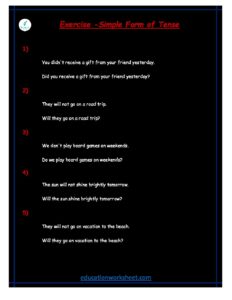changing Simple Tense to negative and interrogative
changing Simple Tense to negative and interrogative
The English language is a versatile tool for communication, offering a variety of tenses to express different actions, events, or states. Among these tenses, the Simple Tense is one of the fundamental building blocks. It enables us to convey straightforward statements, whether they pertain to the past, present, or future. However, for the sake of nuance and effective communication, it is essential to understand how to change Simple Tense sentences into their negative and interrogative forms. In this comprehensive guide, we will explore the intricacies of transforming Simple Tense into negative and interrogative structures, providing you with a thorough understanding of this essential aspect of English grammar.
Simple Present Tense

1.1 Transforming Simple Present Tense into Negative
The Simple Present Tense is used to describe actions or states that are habitual, general truths, or permanent situations. To transform affirmative Simple Present sentences into negative ones, you typically use the auxiliary verb “do” (does for the third person singular) and add “not” after it. The structure is as follows:
- Affirmative: I play tennis.
- Negative: I do not play tennis.
When changing positive Simple Present sentences into negative, it is crucial to remember to use the correct form of “do” according to the subject:
- Affirmative: He plays the guitar.
- Negative: He does not play the guitar.
Questions in Simple Present are formed by inverting the subject and the auxiliary verb “do,” as shown below:
- Affirmative: They study English.
- Interrogative: Do they study English?
1.2 Transforming Simple Present Tense into Interrogative
To transform Simple Present sentences into interrogative sentences, it is necessary to use the auxiliary verb “do” (does for the third person singular) at the beginning of the sentence. The structure is as follows:
- Affirmative: You like ice cream.
- Interrogative: Do you like ice cream?
In the third person singular, “does” is used instead of “do”:
- Affirmative: She watches TV.
- Interrogative: Does she watch TV?
In both positive and negative forms, you can use question words like “who,” “what,” “when,” “where,” “why,” and “how” to create more specific interrogative sentences:
- Affirmative: We visit our grandparents on Sundays.
- Interrogative (with a question word): Why do we visit our grandparents on Sundays?
Simple Past Tense

2.1 Transforming Simple Past Tense into Negative
The Simple Past Tense is used to describe actions or events that occurred and were completed in the past. To transform affirmative Simple Past sentences into negative ones, you generally use the auxiliary verb “did” and add “not” after it. The structure is as follows:
- Affirmative: She visited the museum.
- Negative: She did not visit the museum.
In negative sentences, “did not” is often contracted to “didn’t” for colloquial use:
- Negative (contracted): She didn’t visit the museum.
When forming questions in Simple Past, you use the auxiliary verb “did” at the beginning of the sentence and invert the subject and “did”:
- Affirmative: They watched the movie.
- Interrogative: Did they watch the movie?
2.2 Transforming Simple Past Tense into Interrogative
Converting Simple Past sentences into interrogative sentences follows the same rule as for negatives. You begin the sentence with the auxiliary verb “did” and then invert the subject and “did”:
- Affirmative: He finished his homework.
- Interrogative: Did he finish his homework?
Question words can also be incorporated for more specific questions:
- Affirmative: We went to the beach yesterday.
- Interrogative (with a question word): Why did we go to the beach yesterday?
Simple Future Tense

3.1 Transforming Simple Future Tense into Negative
The Simple Future Tense is used to express actions that will occur in the future. To convert affirmative Simple Future sentences into negative ones, you use the auxiliary verb “will” or “shall” and add “not” after it. The structure is as follows:
- Affirmative: I will call you later.
- Negative: I will not (won’t) call you later.
Both “will not” and the contracted form “won’t” are commonly used to express the negative future.
- Negative (contracted): I won’t call you later.
3.2 Transforming Simple Future Tense into Interrogative
To transform Simple Future sentences into interrogative sentences, you typically begin with the auxiliary verb “will” or “shall,” followed by the subject:
- Affirmative: They will arrive tomorrow.
- Interrogative: Will they arrive tomorrow?
Adding question words can provide more context to the interrogative sentence:
- Affirmative: She will take the train.
- Interrogative (with a question word): When will she take the train?
Section 4: Mixed Tenses and Advanced Usage
In real-life communication, sentences are often more complex than simple affirmative statements, and the transformation into negative and interrogative forms requires some adjustments. Here are a few examples of how to handle mixed tenses and advanced structures:
4.1 Continuous and Perfect Tenses
When dealing with Continuous and Perfect Tenses in both affirmative and negative forms, the auxiliary verbs used remain “do” for Simple Present and Simple Past, and “will” for Simple Future. The main verb is adjusted accordingly. For example:
- Affirmative (Present Continuous): They are playing football.
- Negative (Present Continuous): They are not playing football.
- Interrogative (Present Continuous): Are they playing football?
- Affirmative (Present Perfect): She has eaten breakfast.
- Negative (Present Perfect): She has not (hasn’t) eaten breakfast.
- Interrogative (Present Perfect): Has she eaten breakfast?
- Affirmative (Future Continuous): We will be traveling.
- Negative (Future Continuous): We will not (won’t) be traveling.
- Interrogative (Future Continuous): Will we be traveling?
4.2 Modal Verbs
When dealing with modal verbs like “can,” “should,” “may,” and “must,” the transformation into negative and interrogative forms follows specific patterns. For example:
- Affirmative (Can): She can swim.
- Negative (Can): She cannot (can’t) swim.
- Interrogative (Can): Can she swim?
- Affirmative (Should): You should study.
- Negative (Should): You should not (shouldn’t) study.
- Interrogative (Should): Should you study?
- Affirmative (Must): He must finish the report.
- Negative (Must): He must not (mustn’t) finish the report.
- Interrogative (Must): Must he finish the report?
4.3 Conditional Sentences
Conditional sentences, such as the First Conditional and the Second Conditional, can be transformed into negative and interrogative forms in a straightforward manner. For example:
- Affirmative (First Conditional): If it rains, I will stay home.
- Negative (First Conditional): If it rains, I will not (won’t) stay home.
- Interrogative (First Conditional): If it rains, will I stay home?
- Affirmative (Second Conditional): If I had money, I would buy a car.
- Negative (Second Conditional): If I had money, I would not (wouldn’t) buy a car.
- Interrogative (Second Conditional): If I had money, would I buy a car?
Section 5: Practice and Mastery
Mastery of converting Simple Tense sentences into their negative and interrogative forms requires consistent practice and a solid grasp of the grammatical rules presented in the previous sections. To further enhance your understanding and fluency, consider the following exercises:
- Rewrite the following sentences from affirmative to negative and interrogative forms:
- She sings beautifully.
- They visited Paris last year.
- I will finish my work by tomorrow.
- Write five original sentences in Simple Present, Simple Past, and Simple Future Tenses in affirmative, negative, and interrogative forms.
- Create sentences using modal verbs (can, should, may, must) in affirmative, negative, and interrogative forms.
- Craft conditional sentences in First Conditional and Second Conditional forms in affirmative, negative, and interrogative structures.
- Challenge yourself with more complex sentences involving Continuous and Perfect Tenses, incorporating these into various forms.
By practicing these exercises and reviewing the rules outlined in this comprehensive guide, you can become proficient in converting Simple Tense sentences into their negative and interrogative counterparts. This skill will empower you to communicate effectively in a wide range of situations and contexts, making your English language abilities even more versatile and powerful.


